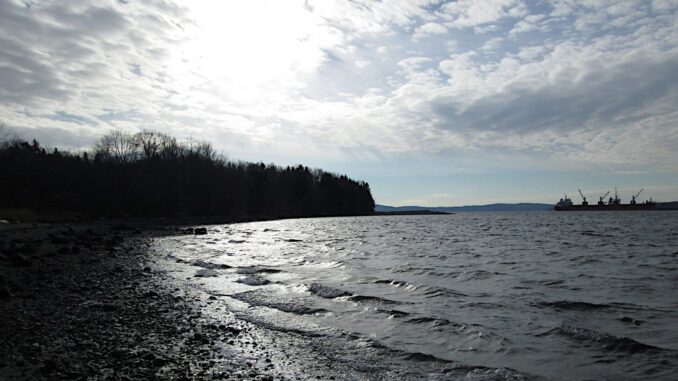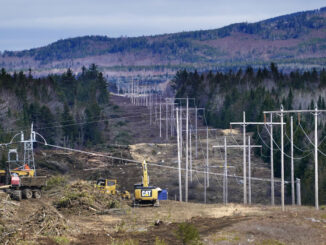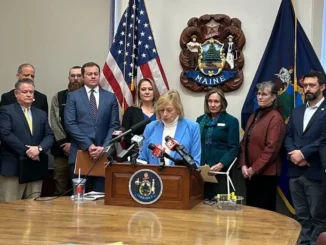
Some environmental advocates are striking a new tone as they urge skeptical neighbors to see the larger climate benefits of a proposed port that would help build future offshore wind farms in the Gulf of Maine.
The fast-warming area of the North Atlantic is thought to have one of the world’s best wind resources in its deeper waters. Tapping into this huge renewable energy potential will likely require massive floating turbines, with a deepwater port to help construct and assemble them before they’re towed out to sea.
A state announcement on one of two potential port sites in the small Midcoast town of Searsport is expected in the coming weeks. Amid a record spate of destructive extreme weather events, conservation groups are stepping up calls for the public to back some version of the port project for the climate’s sake.
“The number one best thing to do for the environment is to get turbines in the water and start generating renewable energy,” said Nick Lund, the advocacy and outreach manager for Maine Audubon. “This is a larger question than just Searsport, because it really does affect all of us.”
Offshore wind is crucial to Maine’s goals for reducing its carbon emissions, Lund said, and offers a unique chance for the state to contribute its resources to the national and global fight against climate change.
Maine Audubon, which predates and is separate from the National Audubon Society, hopes to reframe the debate around the port and offshore wind in general as more than a “lesser of two evils,” he said.
“This type of turbine is not something that can be built elsewhere,” Lund said. “This is a real opportunity to generate a ton of energy completely locally. Other states, other countries don’t have this opportunity.”
Maine depends more on carbon-intensive fuel oil for home heating than any other state, importing it largely from Texas, Louisiana and Canada, according to federal data. The state has encouraged residents to switch to electric heat pumps and hopes to get 80% of its electricity from renewable sources by 2030.
But a boom in local solar projects has raised land-use concerns, and residents have repeatedly pushed back on transmission lines planned to bring Canadian hydropower or land-based wind from Northern Maine onto the regional grid. Some Maine fishing groups also oppose offshore wind development.
Lund said Maine Audubon is trying to turn toward saying “yes” rather than “no” to projects with a net benefit for the climate. The group has spent years developing habitat-minded siting guidance for solar developers, and executive director Andy Beahm wrote a newspaper commentary in 2023 urging support for offshore wind and calling climate change “the No. 1 threat to Maine wildlife and habitat.”
Around the same time, the National Audubon Society put out a report supporting transmission build-out for climate reasons despite potential impacts to birds. Environmentalist Bill McKibben also wrote that summer that “some NIMBY (not in my backyard) passion will need to be replaced by some YIMBY (yes in my backyard) enthusiasm — or at least some acquiescence” in order to fight the climate crisis equitably.
In an interview soon after his commentary was published, Beahm acknowledged that localized energy development may feel new to many Mainers: “Maine is highly dependent on others for our energy,” he said. “As a consequence, we haven’t had to see a lot of the power infrastructure from our communities.”
But his group and others are increasingly arguing that this needs to change. If Maine can’t tap into its offshore wind potential, it could see far more land used for solar, Lund said — or could help drive fossil fuel growth in already overburdened environmental justice areas of Appalachia and the Gulf South.
“If we say no to everything here,” Lund said, “someone else, someone with less power — their land is being developed.”
It will take a rare kind of port to help build and deploy turbine assemblies that are expected to be taller than the Washington Monument, with blades and installation vessels more than 400 feet long, according to a 2021 port feasibility study by the state Department of Transportation.
“Those locations in Searsport are, by far, the sort of best available — certainly in Maine and in New England,” Lund said. “Without a deepwater port, we’re simply not going to have floating offshore wind in the time that we need.”
The state has zeroed in on two potential wind port sites in Searsport: Mack Point, a piece of shoreline that now partly houses a Sprague Energy oil and cargo terminal; and Sears Island, a state-owned conservation area popular for birding and outdoor recreation.
Sears Island is one of the largest undeveloped islands in Maine, managed by a 2009 conservation easement that set about a third of its area aside for a potential future port. The island was unsuccessfully eyed for a nuclear plant, a coal plant, a container port and an LNG terminal in decades past, according to a state committee that overcame “years of acrimony and controversy” to negotiate the easement.
The 2021 study listed Sears Island as a preferable wind port site, partly because building one at Mack Point would require costly dredging. But some Mainers have pushed back hard against the idea of this use for part of DOT’s Sears Island set-aside, with officials predicting protest “sleep-ins” if they go this route.
A state working group has spent more than a year considering ways to minimize Mack Point’s potential cost and dredging issues — with buy-in from the site’s current owner, Sprague — and recent editorials in Maine newspapers have supported it as a better choice over Sears Island.
“Locating the offshore wind port at Mack Point consolidates industry in a single location and removes unused physical remnants of outdated energy production that offshore wind intends to replace with clean, renewable, more sustainable energy production,” Sierra Club Maine director Pete Nichols wrote in the Portland Press Herald on Jan. 18.
Lund said Maine Audubon agrees that Mack Point is the preferable site, and that choosing it could help the state avoid costly legal challenges. “And,” he said, “I’m better with delay than I am with not getting it built at all — that’s really the worst outcome.”
He said his group is most interested in seeing the project move forward, and in working to mitigate and offset any environmental impacts wherever it’s located.



